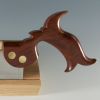If my veneer project works out well, I want to make several replicas of an ogee clock. I have to apply veneer to an ogee curve, perpendicular to the substrate’s long dimension. Folks did this a century ago on the original clock. They used hide glue (I think) but I dread getting into that. In recent years, vacuum presses have been popular, but when I ask around, nobody has used them on the tighter curves of an ogee molding.
Last month, I saw a YouTube video in which Tom Johnson fashioned a caul that mirrored the project face on an antique he restored. That gave me an idea:
Why not pay a fellow who does 3D printing to make a caul that exactly mirrors my substrate? I plan to attach veneer in shorter segments, but I could even join identical 3D printed cauls with steel bars on the back and one side. The cost would be a fraction of the cost to get started in veneer vacuum work.
Has anybody done this? Lessons learned?




 Reply With Quote
Reply With Quote




